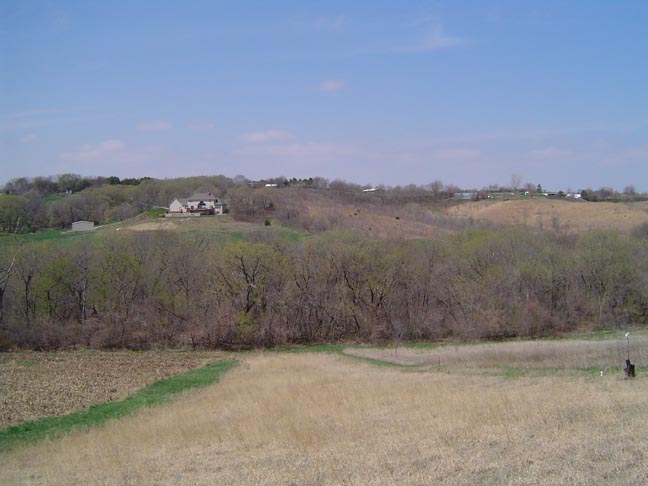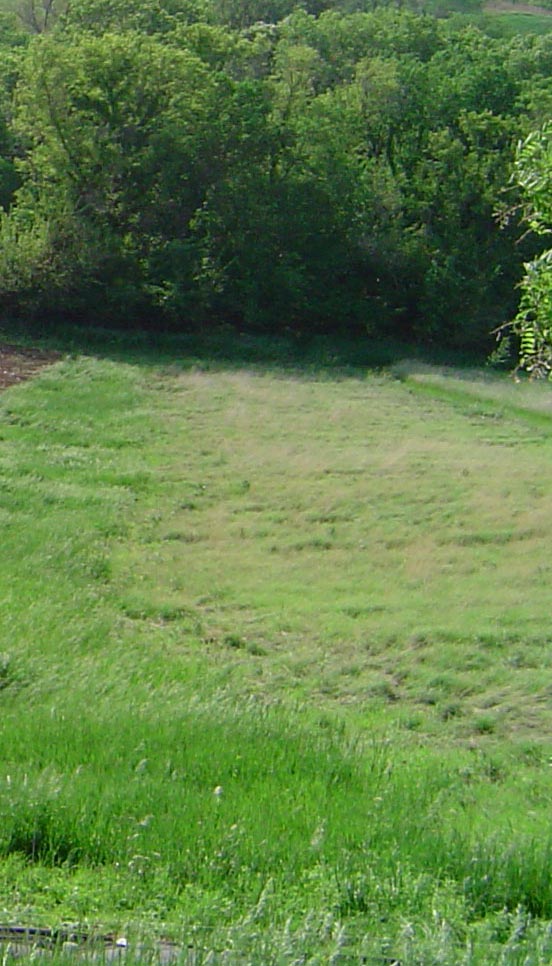
Brome grass in the waterway greens up quicker
Standing out on the hill and looking across at the rural scene was quite pleasant. I guess it was this feeling of calm I got from the view that sold me. I found myself out there for a couple of hours at a time, just being outside. Since I had no way of mowing it, I decided to ask a local farmer to put it into wheat. I always liked the look of wheat fields.
After a few years of that, I happened to go out there one windy July day with the kids. We walked throught the field with flashlights and tromped throught the woods. When we were ready to leave, I noticed an itching sensation creeping into my eyes.
Yes, slowly, a sharp sandpaper seemed to be grinding my eyeballs, just increasing pain for about an hour. I found out, later, about the 'fishhook-like' barbs that are on the little antennae of the wheat by the seeds. In the wind they grab each other and become airborne and land in your eyes.
I realized I would never be able to live next to a field, at least not a wheat field. So, eventually planting some native grass would be a necessity. I thought I would take it one acre at a time.
The Farm Service agency recommended a mixture of 'sideoats grama' and 'blue grama'. They said it wouldn't cost much, only 4 lbs. of seed per acre.
So, after finding out that the seeds cost roughly $10 per pound, I felt a bit like Jack with his magic beans. Standing at the top of a hill with an entire acre of disked up soil, and a little bag of grass seed to cover the whole thing.

After walking up and down the hill in the hot sun, I decided raking an acre would just be silly. I let it go and, amazingly,it worked. This was two years ago. The field is now in its third year of growing and the tufts of 'sideoats grama' are covering about third or more of the area.
Little Green Acre

The bigger tufts are 'sideoats grama'
Now, in the third season, it is mostly 'sideoats grama'. I recently purchased some 'buffalo grass' and some more 'sideoats grama'. If I had disked the seed under the first year, I was told, it would be planted too deep and might not have worked. I guess spreading it by hand is most similar to falling off a grass stalk the way it would naturally happen.
One reason I post this little story is because I was quoted some very expensive rates for hydro-seeding. If you have the time and simply spread the seed by hand, a thick crop of native grass can be planted and filled out in two or three seasons --for the cost of the seed.
I have also found that the more rural seed operations have better prices for seed. Stay away from the big city seed sellers , even if they seem old-timey and rural. For many acres it can get expensive and a 50% difference in price may make it worthwhile to take a drive to a smaller town.
Besides helping with erosion, the grasses also survive the dry hot summer months with little mowing or watering. If the two years wait bothers you, remember, the land is like a long movie show with subtle plot changes. I remember one time being amazed at 7 foot tall weeds where the road crew had denuded the roadside, only to be surprized by brome grass the next season.
The 'weeds' ( yellow foxtail ) that came up the second season were really quite pretty and it is amazing that the seed lies dormant for many years in the soil. The next year,now, the sideoats grama are taking over. Owning land had taught me about how nature takes care of the earth. Usually it is only when we disturb it that we end up with weeds. Weeds are just the first troops into the battle to properly reclaim the area. The birds love a good stand of weeds, but so does the earth. Erosion quickly sets in to bare earth. The roots of plants are like an enormous sponge, slurping up the rain and keeping the earth from becoming a big slurry of mud.
Just like the transistion from field to forest, where the canopy meets the earth and makes it hard to enter, the transition from one ground cover to another is accommodated by various stages of green life. It's interesting. Ok, it isn't THAT interesting. Well, if one were to condense several seasons into a 30 second time-lapse, that might make it interesting... to a child. As we get older, time rushes by so quickly our attention span gets stretched to beyond our lifetimes. Time may seem to be going by too fast, but we are seeing it from a different perspective. Children live in the moment. Adults can too, but they often live in the past (or the future). To bring it back to the present, try watching some grass grow.